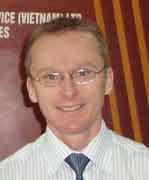 Kalmar's Chinese plant in Shanghai. |
India and China are big markets for materials handling equipment. Their sheer size pose challenges for foreign companies that want a share of the rapidly growing reach stacker market. Forkliftaction.com News reporter Christine Liew speaks to three European reach stacker manufacturers about their business activities in East Asia.
Per Rosengren is Stockholm, Sweden-based Kalmar Industries' product manager for reach stackers. He estimates the global market size for reach stackers to be about 1,000 units with the Asian region growing fastest. Kalmar is the leading reach stacker producer, with more than 40 per cent of the world market.
"There are always unknown quantities as it's difficult to track different manufacturers. We expect this year to be slightly better but there won't be exceptional growth." Rosengren said. Indian reach stacker manufacturers, like Indital Construction Machinery Ltd and TIL Ltd, do not provide figures.
Rosengren said reach stacker global sales grew about five per cent to 10 per cent in 2005, and 2006 could see "close to double-digit growth".
"There's not much growth happening in Europe. Growth in Africa is average and growth in Asia is good. Growth in Latin/North America is slightly lower than the rest of the world. In India and Afirca, although growth is there, it's starting from a fairly low figure of units sold.
"In India there is an explosion of terminal handling which of course is reflective of reach stacker growth. Growth has doubled," he said.
IndiaKalmar has been present in India for nearly 15 years through independent dealers, which the company took over last year. High import duties of about 35 per cent in early 2000 slowed the market, making it difficult for foreign manufacturers to enter. The Swedish manufacturer managed to sell only one to three container handling units to India annually, until last year. The Indian Government has gradually reduced import duties to about 10 per cent and in 2005 Kalmar delivered 150 reach stackers to Asia.
Rosengren said the challenge for foreign manufacturers was to keep pace with the fast development in India's ports and terminals.
"Entire companies are being formed to operate terminals and containers. There is a process of explaining the importance of equipment maintenance and life cycle costs of machines to the Indian market."
 Kalmar Industries' Per Rosengren. |
He said it was understandable newly formed companies focused on the initial cost of equipment because "all expanding markets focus on immediate growth". Many of Kalmar's Indian customers are new companies.
"Our main activity is in Mumbai, which is rapidly growing. Other areas, like Chennai, are growing too," Rosengren said.
Kalmar estimates the total container volume in India to be more than four million TEUs in 2005, a number that has increased 10 per cent a year for the past few years.
The acquisition of its agent Indlift in November 2005 marked Kalmar's goal to establish itself as a port handling equipment provider in India. The Bangalore company, renamed Kalmar India, employs 18 staff and has operations in Mumbai, Khandla, New Delhi, and Vizag (
Forkliftaction.com News #234).
The Bangalore base is Kalmar's main office but it is establishing service points all over India. Rosengren said the sheer size of the country meant there were many centres to establish.
"Kalmar's strategy is to establish itself worldwide. With a market as big as India, we try to keep it in the family, so to speak."
Hiring and training staff was a challenge.
"It's not difficult to find trained people in India. We find good mechanics, technicians and field assistants who have basic knowledge but it's more to do with not having the background knowledge of our kind of operation.
"We are keeping an international standard. So we have to train them in our way of operation, our products and our way of giving service," Rosengren said.
So far, there are no plans for Kalmar to build a plant in India.
"I hope the Indian market will grow to a size where we can have local manufacturing but it will take some time for us to be there."
In Markaryd, Sweden, Kalmar competitor SMV Konecranes, a leading manufacturer of forklifts, container handlers and reach stackers with lifting capacities from 10 tonnes to 60 tonnes, is trying to break into the Indian market. SMV Konecranes has been in India for 18 months. It has only recently entered the market and is running "a number of projects" there.
 SMV Konecranes' Mikael Andersson. |
SMV Konecranes sales director Mikael Andersson said SMV Konecranes was experiencing sales growth for all its product lines with turnover for its entire range doubling over the past five years. Despite no Indian reach stacker deliveries to date, he was optimistic about the market.
"We expect orders in India for this year. It will be a two-digit number and will be among orders of small, medium and big forklifts."
SMV Konecranes is working with one of India's biggest forklift manufacturers, the Voltas group, to sell reach stackers. Andersson said SMV's market strategy varied according to different customer segments. The company's five customer segments are container handling applications; shipping and transport companies; steel mills and steel handling; concrete and construction; and heavy industry.
"In the steel industry we will work with one or two big local dealers that can present our product and give good after-sales support, service and maintenance, and spare parts.
"We are working with the Voltas group. They produce small forklifts so this is a good complement for them to have bigger trucks," Andersson said. Voltas also distributes SMV Konecranes' forklift and container handler ranges.
Voltas Materials Handling, which has offices in Mumbai, Calcutta, New Delhi and Chennai, began in 1964 as a licensee of Yale, USA, manufacturing and marketing diesel forklifts up to three tons and electric forklifts up to 2.5 tons. Today, it designs its own diesel forklifts (up to 20 tons) and electric and LPG forklifts (up to three tons).
Andersson said SMV Konecranes was happy about its co-operation with Voltas because Voltas was a "well-known Indian materials handling supplier, present all over India".
Rosengren and Andersson said foreign manufacturers did not compete with local manufacturers, like Indital Construction Machinery Ltd and TIL Ltd.
"It's hard to even compare prices for locally and foreign-made reach stackers because you're not comparing apples with apples," Andersson said.
"The bigger load capacity or more customised solutions make it more difficult for local manufacturers since they do not have the experience or the options available."
Andersson said examples of container handling machines that only foreign manufacturers could provide in India were 20-60 ton forklifts used for handling steel coils, concrete and marble or to handle machinery in heavy industry. Indian manufacturers do not produce reach stackers with 35 ton to 40 ton capacities for the second container row or 20 tons to 30 tons for the third row or second rail for rail cars.
ChinaKalmar has delivered more than 800 reach stackers to China but high freight costs and long delivery times prompted the opening of Kalmar's Shanghai plant this year.
The 7,000 square metre plant, in Lingang Industrial Park, which produces rubber-tyred-gantry cranes, empty container handlers and masted forklifts, is slated to start reach stacker production in 2007. Fantuzzi was the first foreign manufacturer to build reach stackers in China (
Forkliftaction.com News #253).
Kalmar has operated in China since 1989 and is the biggest supplier of reach stackers, terminal tractors and heavy container stackers for the country's ports and terminals.
"A reach stacker is one of the worst products in the world to ship. It's heavy, bulky and freight costs are high. It takes time. It's reasonable to have local production to lower freight costs and delivery time," Rosengren said.
"Hong Kong and Shenzhen are our strongest areas and the northern Chinese ports of Shanghai and Tianjin are growing rapidly."
He said it was challenging to work in the Chinese market because of the size of the country.
"It's a big country and we have to be able to supply units and support them. We are lucky to have good people at Kalmar Asia-Pacific Ltd who realised this and work not only in sales but support the machines wherever they happen to go in China.
"China is big in area and unit numbers for Kalmar. Overall demand from Chinese customers is pretty high," Rosengren said.
In September 2004, KCI Konecranes acquired SMV and that helped ease SMV's entry into China. With the high cost of transport from Europe to China, access to Konecranes' Shanghai factory has been useful. SMV Konecranes produced its first Shanghai-built empty container handler last year.
SMV Konecranes is building a dedicated factory in Shanghai to manufacture container handling machines. By the end of 2006, it will start producing reach stackers for China and neighbouring markets, like South Korea and Taiwan, to cut transport costs. Steel structures, like the chassis, hand rail and counterweight, will be locally made and the rest of the machine shipped from Markaryd, Sweden.
Andersson said SMV Konecranes' Shanghai plant would have an annual production capacity of 100 reach stacker units.
"We hope to reach that production volume in two years' time," he said.
Italy-based container handling equipment manufacturer CVS Ferrari established its China presence in 1997 and today has 200 reach stackers operating in the country. CVS's Shanghai office oversees its network of dealers, particularly in Ningbo city, in Zhejiang province, the Tianjin area, Dalian city, in Liaoning province, and the Pearl River delta.
CVS Ferrari's sales director Paolo Groppi said the company had no plans to establish a plant in China.
"CVS is trying to be a market leader among customers who still prefer imported machines. We are aware some competitors are opening manufacturing facilities in China and for this reason we like to be different," Groppi said.
He divided foreign manufacturers into two groups, those that produced machines outside China and those that produced at purpose-built Chinese plants.
"A reach stacker needs to be highly productive and reliable and this can only come from high-quality components by reputable OEMs. If you import these components into China, your price becomes comparable to a fully imported product.
"If you accept certain compromises in quality then you can fit in local components but we are convinced the total quality of the machine will not be comparable [to fully imported machines]," he said.
CVS Ferrari has no reach stackers operating in India because "harsh price competition" between Indian-manufactured and Chinese-manufactured reach stackers in India made it difficult for CVS to enter the market, Groppi said.
According to Kalmar's market intelligence, Europe has roughly 50 per cent share of the global reach stacker market; Asia 25 per cent; Latin and North America 20 per cent; and Africa 5 per cent. Per Rosengren, Kalmar Industries' product manager for reach stackers told Forkliftaction.com News container port operators like P&O and APM Terminals don't usually track where they put their machines so the statistics are rough figures. Kalmar's main competitors SMV Konecranes, CVS Ferrari, Terex PPM and Fantuzzi combined, have about 50 per cent of the world market.